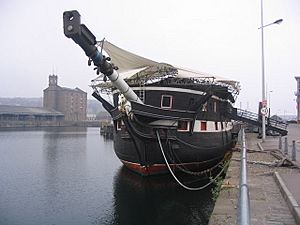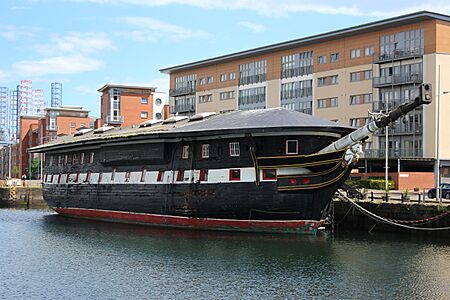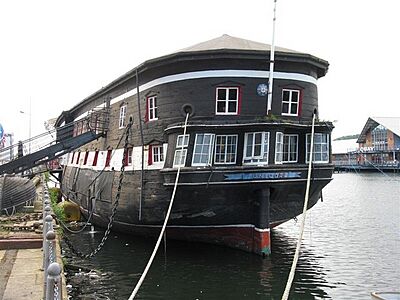HMS Unicorn (1824) facts for kids
 |
|
Quick facts for kids History |
|
|---|---|
| Name | HMS Unicorn |
| Operator | Royal Navy |
| Ordered | 23 July 1817 |
| Builder | Royal Dockyard, Chatham, Kent, England |
| Laid down | February 1822 |
| Launched | 30 March 1824 |
| In service | 1824 |
| Out of service | ~1964 |
| Refit | 1824, refit during construction to receiving/barracks vessel |
| Homeport | Dundee, Scotland |
| Status | Museum ship, Dundee, Scotland |
| General characteristics | |
| Class and type | Modified Leda-class frigate |
| Tons burthen | 1077 bm |
| Length |
|
| Beam | 40 ft 3 in (12.27 m) |
| Depth of hold | 12 ft 9 in (3.89 m) |
| Sail plan | Although never given masts, she was planned as a full-rigged ship |
| Range | Cannot move without tow (never rigged) |
| Complement | 315 |
| Armament |
|
HMS Unicorn is a very old sailing ship called a frigate. She is part of the successful Leda class of ships. Her design was changed a bit when she was built. These changes included a round stern and a special way of building with smaller timbers.
Today, Unicorn is a museum ship in Dundee, Scotland. She is listed as part of the National Historic Fleet. This means she is a very important ship in history. She is the oldest ship in Scotland. She is also one of the oldest ships in the world. Unicorn is one of the last warships from the Age of Sail that is still mostly complete.
Contents
History of HMS Unicorn
HMS Unicorn was built during a time of peace. This was at Chatham Dockyard in Kent, England. She was launched in 1824. This was an interesting time for building ships. It was becoming harder to find good wood. At the same time, iron was becoming more common.
Sir Robert Seppings was in charge of the Royal Navy's ship design. He made sure Unicorn was built with strong iron parts. These iron straps and "knees" helped make her hull (the main body of the ship) very strong.
A Ship That Never Sailed
The naval wars against Napoleon had just ended when Unicorn was built. Because of this, she was never fully set up with masts and sails. Instead, a roof-like structure was built over her main deck. She was then put "in ordinary". This means she was kept in reserve, not used for active duty.
For about 140 years, she served as a hulk. A hulk is an old ship that floats but cannot sail. She was also a depot ship. This means she was used as a floating storage or base.
New Roles and Locations
In 1857, Unicorn was loaned to the War Department. She became a floating gunpowder store. This was at the Royal Arsenal in Woolwich. She returned to her original spot in Sheerness in 1863.
Because she never went to sea, her hull stayed in good shape. In 1873, she was chosen to be a drill ship. This was for the Royal Naval Reserve in Dundee. She replaced another ship called HMS Brilliant. Unicorn was towed on her only sea journey. A steam sloop called HMS Salamander pulled her.
Service in World Wars
In 1906, Unicorn was moved to the Royal Naval Volunteer Reserve. During both World War I and World War II, she was the main office for the Senior Naval Officer in Dundee.
In 1939, a new aircraft carrier was named HMS Unicorn. To avoid confusion, the old frigate became HMS Unicorn II. Then, in 1941, she was renamed HMS Cressy. During the Second World War, she also trained women from the Women's Royal Naval Service. More than 1,500 women trained there. On May 14, 1945, Unicorn accepted the surrender of a German submarine, U-2326.
Saving a Historic Ship
In 1959, after the aircraft carrier was taken apart, Cressy got her original name back. She became HMS Unicorn again. In 1962, her original dock was filled in for a new bridge. She had to be moved. There was a plan to scrap her, but her former captain helped save her.
In 1967, a new building was opened for the reservists. This again put the ship's future in doubt. This led to the creation of the Unicorn Preservation Society. Lord Dalhousie led this group. Prince Philip, Duke of Edinburgh accepted Unicorn on behalf of the society in September 1968.
Because she had not been used much, her wooden parts were well preserved. In the late 1960s, plans began to turn her into a museum ship. The roof over her upper deck is thought to be original. Some parts were removed in the 1970s. These parts, like the foc'sle roof, were later replaced by people working to preserve her.
In April 2019, the Unicorn Preservation Society received a grant. This was from the National Lottery Resilient Heritage Fund. The grant was for £28,900.
Modern Preservation Efforts
In March 2021, experts checked the frigate. They found that most of the wooden planks were in very poor condition. Even newer planks from the 1850s had decayed. However, one restorer said that Unicorn is likely the most original old ship of her kind. Almost everything inside is from when she was built. It has not been rebuilt much over time.
The ship was planned to move to the nearby East Graving Dock for major repair work. This project is called Operation Safe Haven. The goal is to create a maritime heritage center for the ship. The Unicorn Preservation Society has been looking for donations of large oak trees. These are needed to replace the old planks and make the hull stronger.
Important donations have been received. This includes £1.11 million in July 2023 from the National Heritage Memorial Fund. In January 2025, it was announced that the ship received about £796,000 (about $1 million USD) from the UK National Lottery. This funding is part of a larger restoration project. The project is hoped to cost £10 million (about $12 million USD) in total. The preservation society worked to raise more funds to show the project was possible.
Similar Historic Ships
Unicorn has a sister ship named HMS Trincomalee. This ship has also been saved. She is now a main attraction at the National Museum of the Royal Navy in Hartlepool.
Trincomalee and Unicorn are the second and third oldest ships still floating. The oldest is the USS Constitution, built in 1797. Experts believe Unicorn is the most original preserved ship from her time. About 90 percent of her original materials are still there.
Gallery
See also
 In Spanish: HMS Unicorn (1824) para niños
In Spanish: HMS Unicorn (1824) para niños






